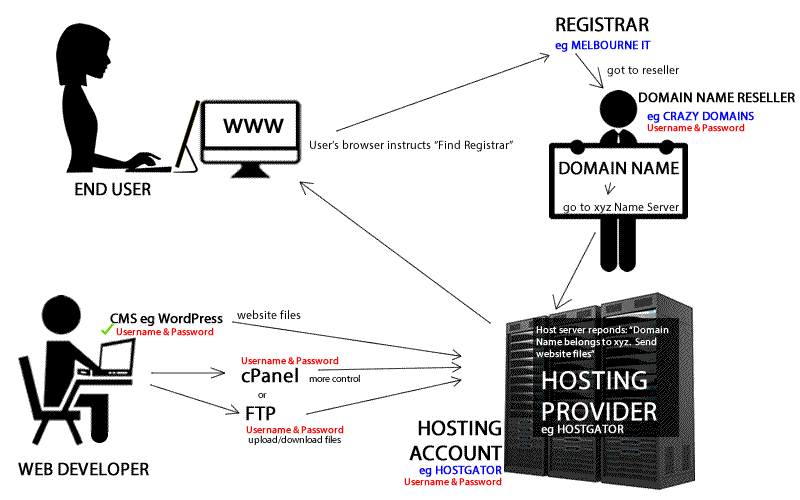Hosting? DNS? cPanel? Registrar?

What do these terms mean? Do you feel somewhat overwhelmed when your website developer asks for the username and password for your Hosting, Host Server Account, cPanel, FTP, Domain Name Registrar, and website? Why you have so many anyway? Here’s a quick explanation of these terms.
Domain Name – This is your website address, such as mycompanyname.com.au
Registrar – The Domain Name Registrar is the provider responsible for registering your domain name. Some commonly known Registrars are Hostgator, CrazyDomains and Namecheap. You probably pay them between $10-25+/yr. Part of their service is allowing you to input the IP address or ns1 & ns2 of where you have the hosting of your website files. Think of it as keeping a list of your name and telephone number. You can change your number if you move to a different host server.
Hosting Provider – This is the company that you have bought server space from, i.e. space on their computers. Its like renting office space. Hostgator, Siteground and aSmallOrange are hosting providers. Generally, they charge $100-$200/yr for shared server space.
Host Server – The name of the particular server allocated to you by the Hosting Provider. They may name them interesting names or just give them numbers. Like the name of the rooms you are renting, and just like a floor of a building may have many different offices, often host servers are “shared” with several customers besides yourself.
cPanel – Once you have your host server, the provider will give you a username and password. Its like getting the keys to the office. If you do not get them then it will be very inconvenient for you, to say the least! If you get hosting and DON’T get cPanel access, you may like to think seriously about changing providers.
FTP – File Transfer Protocol with its username and password is a way of uploading and downloading to the server that you’ve been allocated. Its different from cPanel access. Its like getting the keys to the storeroom but not all the other rooms.
WordPress details – gives you the ability to log into the back end of your website (if its built on WordPress). Its like being able to get behind the counter at your shop. Userful if you’re an employee – but only part of the story if you are the owner!
SSL – Secure Socket Layer – is the green lock or similar that shows up on your browser, near the url of a website. This shows everyone that the website is encrypted. When we view the website in our browser the website sends encrypted files. This is much more secure and protects from injection of malicious code by hackers and others. Sites that do not have SSL are not ranked highly by Google.

It is highly recommended that you have both hard copy (printed on paper) and soft copy of all your account details, such as your registrar (domain names) and server (hosting account and cPanel). Some of these details (site addresses, usernames and passwords) may still be in emails that were sent to you when you originally acquired your domain name or hosting service. Do find them and make a backup record as a matter of priority. If the account details are in the hands of your developer, please ask them to give it to you, as the accounts are your property!